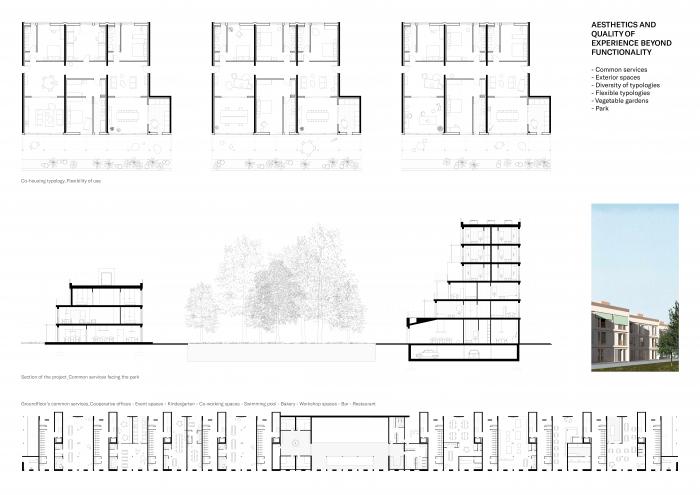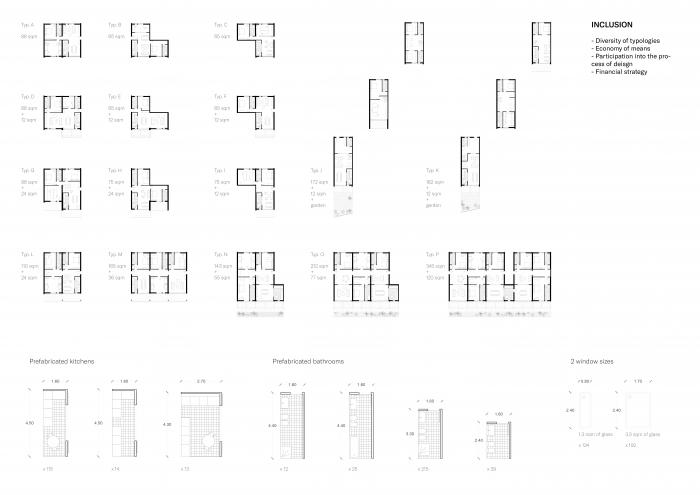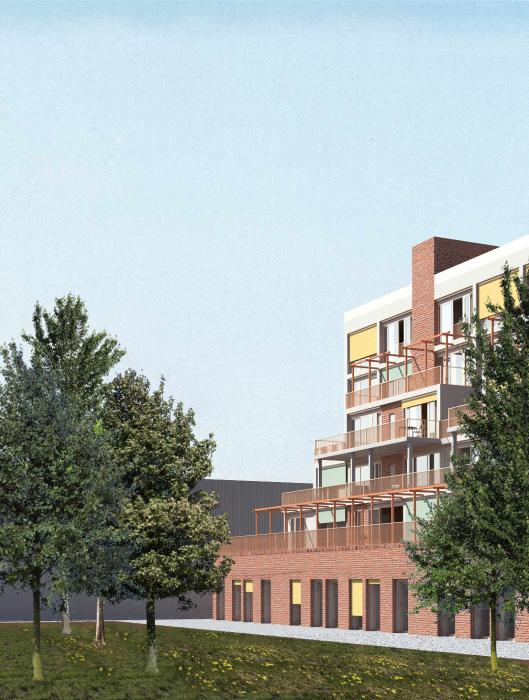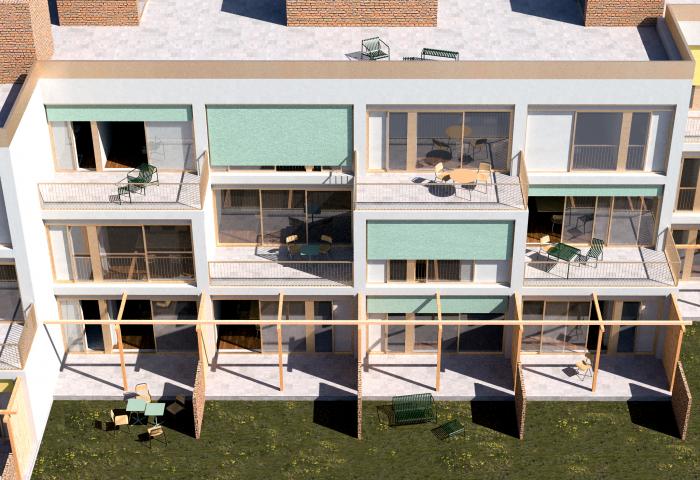Non-speculative co-operative ownership and land management, developed on the dismissed areas provided by the municipality, can help to have more equal distribution of land and access to quality housing in Milan, indispensable conditions of quality urban life. On which it can be developed housing projects providing freedom of use, high diversity of typologies and great quality of services that are accessible for all, thanks to strategies of re-use and economy of means.
Milan has once been a booming industrial city, spread on all the Lombardia’s territory. Since we shifted to service economy, a high number of lands are not in use anymore. And as a consequence, Milan is growing through International investments made into large urban regenerations. Which is increasing the land’s prices and the need for housing stock in the city. The 2021 report of Housing Europe is stating that only 3% of the entire residential buildings are social housing in Italy. In order to stop the struggle to find affordable housing, the domestic space should exit the concept of financial product.
The municipality is firstly putting in regeneration the lands closer to the historic city-center and therefore highly attractive for investors. Nevertheless the list of dismissed areas in Lombardy is still long and composed by sites with very different contexts. I believe this list is an opportunity to initiate a social resistance to the land’s value speculation.
As an alternative to privatization of property, but also an alternative to public social housing that the municipality is not able to provide any more, the co-operative ownership and land management is a financial and social organization that is non-speculative and social inclusive. In order to make these co-operative initiatives affordable and accessible for all, the land’s price is the main obstacle. To this extent, I will consider that the role of the municipality in the development of a more equal and affordable housing stock is limited of giving access to the dismissed areas, taking form by a long-term (75 years) leasing contract at very low and fixed rent.
To conclude, I would argue that anticipating the speculation of land’s prices in the periphery, with the non-speculative co-operative ownership and land management, developed on the dismissed areas provided by the municipality, can be one of the strategy to have more equal distribution of land and access to quality housing in Milan’s future.
Please highlight how the concept/idea can be exemplary in this context
Environmental sustainability has been addressed on different levels within the project.
On one hand, the land on which is taking place the cooperative is a dismissed area of the Lombardy’s region. Re-qualification of the later means that construction can happen without reducing once again the quantity of fertile soil since it is already a polluted one, besides it will enhance a regeneration of the quarter and finally the impact on the environment can be lowered by re-using materials already present in the area.
On the other hand, among all the 139 dismissed areas listed by the region, I have chosen this one for its proximity to infrastructure and services. In my opinion this project can be sustainable in the long run only if its geographic position is suitable for a cooperative housing. In fact the foot distance of the public transport, supermarkets and green areas were important settings. The hospital, school and university quickly reachable with transports rise its legitimacy.
Moreover inside the architectural proposal, a great park has been integrated as the heart of the cooperative. In addition of the private gardens for the row-houses. In total it’s 6300 sqm dedicated to green areas. The relation with nature is encouraged also with the roof-gardens at the disposal of the inhabitants to grow their food.
Finally I would like to argue that sustainability lays also in the capacity of the building to evolve with its inhabitants’s way of life. Therefore I have decided to use a cross wall construction. The loads are transferred by slabs positioned at a distance of around five to six meters. There are no load-bearing outer walls. This makes room-high and room-wide wall openings possible. With these advantages the layout of the apartments is composed by a grid of 5 by 4 leaving a volume big enough to be used in many diverse ways, changing along with the will of the dwellers.
Please highlight how the concept/idea can be exemplary in this context
In this project the aesthetics and quality of experience beyond functionality could be represented with two features: great amount of common services and exterior spaces; high diversity of apartment’s typologies.
As Harry Gluck initiated in Vienna, the development of large scale social housing allows the integration of services considered only for the rich. He considered the social aspects of housing to be just as important as the structural ones, and it couldn’t be more contemporary with the current pandemic situation. In addition of the green areas, that I have mentioned for environmental sustainability, the ground floor of the cooperative is composed by services. Besides creating social activity and a feeling of belonging, they cover a large spectrum of fields such as education (nursery), sports (inside swimming pool and outdoor basket court), work (co-working and workshop spaces), leisure (event spaces and bar) and food (bakery and restaurant).
Common spaces are not the only ones designed to enhance the feeling of luxury or collective bonding. A high diversity of domestic space has been advanced, and each of them composed by an exterior space. If you want to live alone or with other 10 people, one of the layout could fit the need. Various degree of intimacy is also represented, with the co-housing connected to the communal terraces, the co-housing row-houses having a private garden, individual apartment with its balcony, etc… Finally as already specified for another question, the structure and measurement of the building creates rooms with constant sizes to enhance the flexibility within the typologies.
To sum-up the project tries to give the maximum of freedom of use, diversity of life styles and quality of services.
Please highlight how the concept/idea can be exemplary in this context
The nature of the project is born looking for a solution to achieve more inclusion in Milan. To be precise, it’s after a research and an interview about the current building operations and their impact on the economy that I understood the important need for inclusive affordable housing in that city.
However affordable housing is not inclusive if it cannot give diversity and quality for its inhabitants. Building a community can be helped by architectural choices, for instance cooperative’s systems allows future inhabitants to participate in the process of designing their domestic spaces as it could give the best experience of living it can. Furthermore all the services included into the project enhance the engagement of each cooperative’s member to care and join the neighbourhood dynamics. It creates social interaction, feeling of belonging that are both considered as human needs.
Inclusion is reached when quality housing is offered to all. In order to feel at home is not depending on the ownership of the domestic space but rather on the feeling of safety it gives, feeling good at home implies a form of protection and the right to stay.
As for reaching affordability for a good quality of housing, with generous spaces, indoor’s as much as outdoor’s, developed in many various ways in order to address the wider range of living’s types possible, has been imagined through economic strategies. Using industrialised production, repetitive construction, and the sequencing of similar modules allows larger spaces and better quality of experience. In particular in this project, components of that economy of means are: prefabricated bathrooms, prefabricated kitchens, declination of only two window’s sizes and cross-wall construction.
Like mentioned already, the cooperative project contain a great typological diversity, each of them highly flexible. That feature was integrated for being the most inclusive possible on the diverse living scenarios for each individual.
Please highlight how this approach can be exemplary
As you probably noticed, some elements are advanced as argument under more than one dimension, which clearly state the co-existence of environmental sustainability, quality of experience and inclusion into the proposal. Moreover as an architectural design, it is by nature that several dimensions collaborate together for the purpose of one project.
Key elements that underline these three dimensions:
- ‘Non-speculative’, addresses in priority the inclusion’s thematic. Nevertheless the aesthetic and quality of experience are increased only by the fact that the actors that make decisions about the design are not developers. It will not be the simple result of financial rentability.
- ‘Cooperative Housing’, is gathering all the three dimensions. High amount of services, larger spaces, social interaction, personalised layout are all part of a greater quality of experience, then the financial strategy behind a cooperative housing is bringing inclusion as a foremost feature and, finally the feeling of belonging created by the elements just exposed is guaranteeing a long-life for the building and it’s community.
- ‘Dismissed areas’, is firstly an environmental aspect. Re-using abandoned territory and materials from the existing building is definitely lowering down the carbon footprint of the operation. Although it can be considered as a quality of experience to incorporate the history of the site through re-used materials. Finally re-development of a dismissed area has for consequences to regenerate the surroundings and therefore it also talked about inclusion of former isolated quarter.
Non-speculative cooperative housing on dismissed areas has already been developed in other European countries such as Spain, Austria, Netherlands and Frances. But compare to the entire housing market it’s still remains rare initiatives. Even if some cooperative organisations are present in Milan, their financial strategy have never used yet a long term lease from the municipality on dismissed areas.
Implenting it on Italy’s territory would be a great challenge for the legal and economic part. In particular in regards with the re-use of building materials and former industrial sites. As for examples and knowledge I would turn myself towards the pioneer of non-speculative cooperatives, Mietshaüser Syndikat (self-governed organisation founded in Germany in 1990), known for being solicited in order to build a similar model of organisation in other countries. Furthermore, about the processor the land lease by public institutions I would look at the project La Borda, operated by Lacol.
I am convinced it is a need here in Milan, members of Comitato Nazionale are often communicating on the inequality of housing and how it can be lowered. As the president of Federcasa, Luca Talluri said: ‘In Italia servono più case popolari e una nuova idea di edilizia residenziale pubblica . Al tempo stesso occorre investire risorse importanti sul piano periferie, per consentire una riqualificazione vera delle aree ad alta densità abitativa, in termine di vita di quartiere e di qualità dell’abitare, elementi che contraddistinguono la nostra quotidianità.’ (In Italy we need more social housing and a new idea of what is public housing. At the same time, investing great resources on the periphery, to allow a true redevolpment of the high density residential areas, in matters of quarter’s life and quality of living, elements that contradicts our every day life) He added that at least 300.000 housing units are needed.
This site is particularly interesting for its geographical ambiguity in relation to the boundaries of Milan’s commune. Also for its very good transport connection to the historic city-center of Milan and its insertion in-between different urban regeneration already started. These three aspects can assure us the future rise of land’s prices in this area, and therefore the need to anticipate it by implementing a non-speculative co-operative ownership and land management. In addition, the neighborhood is already well furnished in services, such as hospitals, sports field, supermarket, market, schools, churchs... And with the Parc of the Balossa, we can also include a proximity to ‘nature’.
This kind of analysis is definitely a priority before designing any project, and in order to understand if a big difference could be made with the non speculative cooperative housing based on a leasing from the region of dismissed areas it would be relevant to know how many sites are suitable for it.
Besides the comprehension of the possible scale of action on the region, I would look for developing the one I began to dig in. From contacting ‘Comitato Nazionale per l’Housing Sociale’ to deep researches for materials re-uses in Italy, passing by asking feedback from existing cooperatives in Milan, there is a completely new path for this country to create in the field of social housing.
In fact the ‘Comitato Nazionale’ is exactly looking for this type of project, that blend finance from public and private parties with flexible typologies and sustainable criteria. I am therefore confident in their interest of helping me conduct this project. In addition, in the phase of research for this design I am presenting, I have conducted an interview of an architect working in a cooperative, which helped me a lot see the gap between Italy and some other European country for their history, visions and initiatives of social housing. Her advices and knowledge would be of great help in the future.
In the scope of one year I believe that the following steps could be accomplished:
- Starting the discussion with ‘Comitato Nazionale’ which represented several Italian institutions that works to provide more affordable housing in Italy
- Once I have their advices and knowledge of the Italian institutions I would ask them to support me for contacting the commune of Milan about the possibility of a leasing of 75 years for one of the dismissed areas they listed
- If they are keen to hear more about the idea I could offer an analysis of all the 139 sites based on criteria such as proximity of public transports, local suppliers etc.. in order for them to see if the operation could be done in other sites, and therefore launch an open call for cooperatives to be created
- Meanwhile I would contact the studios that are part of the Interreg's initiative and wrote the guidelines for reusing building materials, to ask them advices for me to find a company that would be skilled in that domain here, in Milan. The interests could be greater if more than one project will be needed a operation of careful strip-out to re-use elements (depending con the results of the site’s analysis)
In the long run, hopefully these steps would be carried out and the moment of gathering a team for following the project and the creation of the cooperative would come. Once the participants of the cooperative are found, the architectural project will be able to be shaped with a detailed needs of each of them. Discussing about their future collective and domestic space is a great starting point for the community.
@Allegre, 2022
Content licensed to the European Union.





